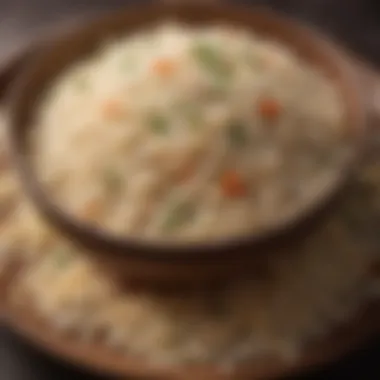Delicious Chicken Fried Rice: Ingredients and Tips


Intro
Chicken fried rice is a dish that marries simplicity with versatility, making it a well-loved choice across diverse culinary landscapes. Rooted in Asian cuisine, it has transcended borders and become a staple in many households. This article presents a thorough exploration of the ingredients essential for crafting a flavorful chicken fried rice. Understanding the role each component plays not only enhances flavor but also elevates texture, ensuring a gratifying meal.
This guide alongside insights on ingredient selection aims to empower home cooks. Recognizing variations that cater to differing palates and dietary preferences is also crucial. Furthermore, practical suggestions for preparation and storage will simplify the cooking process. For those with busy lives, chicken fried rice can be a quick solution, allowing one to enjoy a homemade dish without sacrificing taste. Let’s delve into the details.
Understanding Chicken Fried Rice
Understanding chicken fried rice is essential as it lays the groundwork for mastering this classic dish. Chicken fried rice is not just a meal but an experience that combines various textures and flavors. By analyzing its components, one can appreciate the cultural significance, meal preparation process, and variations that cater to different tastes and dietary needs.
Culinary Origins
Culinary origins of chicken fried rice trace back to Asia, where rice has been a staple for centuries. It is said that fried rice was invented during the Sui Dynasty in China, originally created as a way to utilize leftover rice. Over time, this dish evolved, taking on varied forms across cultures. In each region, locals adapted it based on available ingredients and customs.
Regional variations leave noticeable marks on the dish. For instance, "Nasi Goreng" in Indonesia integrates sweet soy sauce and sambal, while in Thailand, stir-fried rice often includes fish sauce and a twist of lime. Understanding these origins enriches the appreciation of chicken fried rice as a versatile culinary canvas.
Basic Concept and Composition
The basic concept of chicken fried rice revolves around a simple yet effective combination of cooked rice, chicken, and vegetables, stir-fried together. The harmony of these ingredients results in a balanced dish. The ability to incorporate various vegetables, proteins, and sauces provides endless customization options.
Each component plays a crucial role:
- Rice: Acts as the foundation. It should be dry and fluffy to ensure that each grain remains separate after cooking.
- Chicken: Provides protein. Choosing the right cut can influence the overall flavor and texture.
- Vegetables: Adds color and nutrition. Popular choices include peas, carrots, and scallions.
This dish illustrates how simple ingredients can combine to create complexity, offering both taste and nourishment. To achieve the best results, careful consideration must go into selecting ingredients and understanding their roles within the dish.
Essential Ingredients Overview
Understanding the essential ingredients for chicken fried rice is critical for achieving the desired flavor and texture in this popular dish. This overview provides insight into the necessary components and highlights the significance of each one. It also emphasizes the importance of quality in ingredient selection as it directly influences the final outcome of the meal.
The core ingredients, the choice of rice, and the selection of chicken are pivotal to the preparation. When prepared correctly, chicken fried rice can deliver a satisfying and nourishing experience. The specific qualities of these ingredients, combined with cooking methods, create layers of flavors that are distinct yet harmonious. Therefore, careful consideration and selection of each element are essential.
Core Ingredients for Chicken Fried Rice
The foundation of chicken fried rice includes rice, chicken, vegetables, eggs, and seasonings. Each contributes uniquely.
- Rice forms the base of the dish and should be fluffy enough to separate easily.
- Chicken provides protein and texture, helping to elevate the overall satisfaction of the meal.
- Vegetables add color and nutrition, infusing the rice with freshness.
- Eggs are often included for texture and richness, acting as a binding agent.
- Seasonings, particularly soy sauce, add depth; they bring the dish together and should be chosen wisely.
Importance of Rice Selection
Rice is arguably the most important ingredient in fried rice. The type you choose directly impacts the dish's texture.
Type of Rice
Choosing the right type of rice is essential. Long-grain rice like Jasmine or Basmati is a popular option. These types stay separate when cooked, which helps prevent the dish from becoming mushy. Their light and airy texture allows for better absorption of flavors as well.
In contrast, short-grain rice tends to be more sticky and can result in a clumpy dish. While some might prefer the stickiness, it often does not provide the ideal experience for fried rice. Thus, opting for a long-grain variety is generally more beneficial for this recipe.
Pre-cooking Methods
The pre-cooking methods you use can affect the final result significantly. Stale or day-old rice works best for fried rice. It has had time to dry out slightly, which reduces moisture levels. Consequently, it cooks evenly, preventing excessive stickiness during stir-frying. If using fresh rice, allow it to cool down after cooking thoroughly, or spread it out on a tray. This technique allows steam to escape and avoids the clumping of grains later in the cooking process.
Choosing the Right Chicken
Selecting chicken is another important consideration in preparing chicken fried rice. The quality of chicken chosen can enhance or diminish the dish's quality.
Fresh vs. Frozen Chicken


Fresh chicken is usually preferred for its tenderness and flavor. When fresh, the meat retains moisture; this contributes to a more satisfying mouthfeel. However, frozen chicken can be a convenient option. When selected wisely and thawed properly, it can still yield a delicious meal. The important part is to ensure proper thawing to prevent any texture changes that can occur if not handled correctly.
Cut Preferences
The cut of the chicken is also important. Common options include diced breast or thighs. Chicken breast is lean, while thighs are juicier and richer in flavor. Chicken thighs can add depth to the overall dish and are often recommended for fried rice. Choosing between these depends on personal preference, but being aware of their textures can help when deciding what combination might work well.
In summary, each component of chicken fried rice plays a crucial role. Ensuring the selection of quality ingredients and understanding their characteristics can greatly impact the success of the dish. This detailed perspective on the essential ingredients sets the stage for a more successful culinary experience in preparing chicken fried rice.
Flavor Enhancers
Flavor enhancers play a crucial role in elevating the overall taste and experience of chicken fried rice. The choice of ingredients used for flavor enhancement can greatly impact the final dish. They not only improve the taste but also complement the main components, providing balance and depth. Key flavor enhancers include vegetables and condiments, each bringing its own unique characteristics to the mix. The right selection can make the difference between an average meal and a memorable one.
Vegetables: Selection and Preparation
Common Vegetables Used
The vegetables in chicken fried rice are fundamental to its flavor profile and texture. Commonly used vegetables include peas, carrots, and bell peppers. These vegetables are often chosen because of their vibrant colors and flavors.
- Peas add a slight sweetness and vibrant green color.
- Carrots introduce a subtle crunch and natural sweetness.
- Bell peppers provide both sweetness and a slight bitterness that adds complexity.
Including these vegetables enhances the nutritional value of the dish and contributes essential vitamins. These ingredients are popular choices largely due to their availability and ease of preparation. Some people may find cooking with vegetables appealing because they can be easily chopped and stir-fried. However, their freshness directly influences the dish. Using pre-packed frozen mixtures is a common practice but can affect texture.
Substitutes Based on Preference
Not every cook will prefer the same vegetables. This section provides options to swap common ingredients for alternatives based on personal taste. Options like broccoli or zucchini may appeal to some individuals.
- Broccoli is rich in nutrients and adds a crunchy texture.
- Zucchini absorbs flavors well and is low in calories.
These substitutes allow for customization without sacrificing the overall integrity of the dish. It is advantageous because not everyone enjoys traditional fried rice vegetables, and personal tastes can vary widely. A noteworthy point is that experimenting with different vegetables might lead to a unique dish that resonates more with one’s palate.
Soy Sauce and Other Condiments
Types of Soy Sauce
Soy sauce is a staple for flavoring chicken fried rice. There are different types of soy sauce available, such as light soy sauce and dark soy sauce.
- Light soy sauce is saltier and thinner, making it ideal for seasoning.
- Dark soy sauce provides richness and sweetness and imparts a deeper color to the rice.
The choice between these types influences not just the taste but also the visual appeal. Light soy sauce tends to be more popular in fried rice dishes because it does not overpower other flavors. However, using too much can lead to an overly salty dish, which is something to keep in mind during preparation.
Alternative Seasonings
There are various other seasonings that can be used alongside or instead of soy sauce.
- Oyster sauce adds a slightly sweet and savory dimension.
- Teriyaki sauce can bring a different profile with its blend of sweetness and savoriness.
These alternative seasonings have their own unique characteristics that can significantly impact the flavor of chicken fried rice. They can be beneficial for those looking to experiment or mask the taste of certain ingredients. However, one must be cautious, as excessive use can overshadow the dish’s intended flavor balance.
Additional Ingredients for Texture
Texture plays a vital role in chicken fried rice. It elevates the overall sensory experience of this dish. The right combination of ingredients can provide contrast, making each bite enjoyable. In this section, we will look into how eggs and oil contribute to achieving the desired texture.
Egg: The Binding Element
Eggs are essential in chicken fried rice. They add richness and act as a binding agent. A good balance of chicken and vegetables is necessary. Eggs help incorporate all the ingredients harmoniously together.
Whole Eggs vs. Egg Whites
Whole eggs bring more flavor to the dish compared to just egg whites. They offer a vibrant color and richness that enhances the overall taste. On the other hand, egg whites have less fat. They can be a choice for those looking to reduce calories. However, using only egg whites may result in a drier texture. Therefore, whole eggs are generally preferred for a moist and cohesive dish. Their unique feature lies in their ability to keep the rice from becoming too dry or crumbly.


Preparation Techniques
How eggs are prepared influences the final outcome. One common method is to scramble the eggs before adding them to the fried rice. This method ensures even distribution throughout the dish. Alternatively, you can create a small well in the middle to fry the eggs directly in the pan. This allows them to cook more thoroughly. Both techniques have their advantages, with scrambling often being quicker and easier.
Oil Selection
Choosing the right cooking oil is crucial. Different oils can vary in flavor and health benefits. Selecting appropriate oil affects both the taste and texture. A well-chosen oil enhances the richness of the dish. It also impacts how well the rice gets cooked.
Types of Cooking Oils
Common choices for oils include vegetable oil, canola oil, and sesame oil. Vegetable oil is neutral, making it versatile. Canola oil withstands higher temperatures without smoking. Sesame oil, with its nutty flavor, can add depth. Each type of oil offers a unique flavor profile. This variability allows cooks to tailor the fried rice to their preferences.
Effects on Flavor and Health
The chosen oil can impact both flavor and nutrition. Oils like olive oil are known for their health benefits. They are rich in monounsaturated fats. However, they can impart a strong taste when used in high heat, making them less ideal for fried rice. Oils with more neutral tastes like canola oil have less effect on flavor, allowing other ingredients to shine through. The balance between flavor contribution and healthiness must be taken into account. Not all oils are created equal.
Important Reminder: Using oils that can withstand high heat retains flavor while keeping the dish healthy.
Ultimately, both eggs and oils are essential to achieving the right texture in chicken fried rice. These components not only unite the dish but also add depth and flavor.
Preparing Chicken Fried Rice
The process of preparing chicken fried rice is crucial to achieving a well-balanced dish. Understanding the steps involved not only enhances the flavor but also improves the overall texture. This section aims to demystify the preparation process, offering clarity on critical components that can elevate a simple recipe into a delicious meal.
Preparation Steps Explained
Marinating the Chicken
Marinating the chicken serves multiple purposes. It adds depth to the flavor of the meat, ensuring it is tender and juicy after cooking. Generally, a marinade includes soy sauce, garlic, and ginger, which infuse rich flavors that complement the dish.
The key characteristic of marinating is its time requirement. Although it may take extra time, the benefits outweigh the wait. The unique feature of marinating is that it allows flavors to penetrate deeper into the meat. If chicken is simply cooked without marinating, it can taste bland and dry. Therefore, taking the time to marinate leads to enhanced flavor and moisture retention.
However, there are disadvantages to consider. Over-marinating can lead to a mushy texture. Hence, it’s essential to follow the recommended marination time to achieve optimal results. A well-marinated chicken contributes significantly to the overall satisfaction of the dish.
Cooking the Rice
Cooking the rice correctly is fundamental to any fried rice dish. The texture of rice should be firm but not sticky, allowing it to fry well without clumping together. Using cold, leftover rice is often recommended. It is firmer and easier to handle during the cooking process.
One of the critical aspects of cooking rice is the rinsing process. Rinsing removes excess starch, which can lead to tackiness. When it comes to cooking, ensuring the right water-to-rice ratio is crucial. This precision helps achieve that ideal fluffy texture that distinguishes good fried rice from mediocre.
A unique feature of cooking the rice involves understanding cooking methods. Boiling or using a rice cooker are common techniques that can yield favorable results. Each technique has its advantages, such as ease or perfect texture, but both require careful attention to the cooking time and overall moisture.
Cooking Techniques
Stir-Frying Essentials
Stir-frying is the cooking technique that defines fried rice. This method is characterized by high heat and quick movement in the pan, often utilizing a wok. Stir-frying allows ingredients to cook rapidly while maintaining texture and color. This technique keeps vegetables crisp and avoids overcooking the chicken.
The key advantage of stir-frying is its ability to enhance flavors through the Maillard reaction, which produces a complex taste profile. A special aspect of stir-frying is its speed. Cooking must be done quickly, which means preparation ahead of time is crucial. However, if not executed correctly, stir-frying can lead to burnt food or uneven cooking.
Heat Control
Heat control is vital when stir-frying. Different ingredients require different cooking times, and managing the temperature allows for necessary adjustments. Too high a heat can burn the ingredients, while too low can make the dish soggy and unappetizing.
A key characteristic of proper heat control is the ability to move ingredients around quickly. This action ensures even cooking while also allowing for aromatic flavors to develop. An aspect often overlooked is the residual heat from the pan, which continues to cook the food even after it’s removed from the heat source.
Effective heat control makes a significant difference in the outcome. It’s paramount for ensuring both visual appeal and taste remain intact. Being attentive to the cooking process pays off, ultimately leading to a more enjoyable chicken fried rice experience.
Variations and Dietary Adaptations


Understanding variations and dietary adaptations is significant when discussing chicken fried rice. This dish can be customized to accommodate different dietary restrictions and personal tastes, making it versatile and accessible. By exploring various options, the dish not only retains its fundamental appeal but also embraces wider culinary preferences. This section reviews vegetarian, vegan, and gluten-free adaptations, offering an inclusive approach to this beloved meal.
Vegetarian and Vegan Options
Plant-Based Protein Sources
Plant-based protein sources are essential for crafting a vegetarian or vegan version of chicken fried rice. These sources include ingredients like tofu, tempeh, or seitan. Tofu, for example, can absorb flavors well and provides a satisfying texture in the dish. Its high protein content serves as an effective substitute for chicken while being lower in fat compared to meat. This makes it a popular choice for health-conscious eaters looking for alternatives without compromising on taste.
The unique feature of plant-based proteins is their ability to enhance the nutritional profile of fried rice. They not only add bulk but also contribute important amino acids and minerals. However, some may find the texture of tofu or tempeh unfamiliar. This might lead to a less enjoyable experience for those unaccustomed to plant-based proteins. Nonetheless, when prepared with proper seasoning and techniques, they can seamlessly integrate into the dish.
Modifying Ingredients
Modifying ingredients is a key aspect of creating a vegetarian or vegan chicken fried rice. This may involve substituting traditional flavors with plant-based ones. For instance, using vegetable broth instead of chicken broth provides depth without animal products. Likewise, adding nutritional yeast can introduce a cheesy flavor that mimics umami notes common in classic versions.
The hallmark of modifying ingredients is their ability to cater to various dietary preferences without sacrificing flavor. By doing so, cooks can maintain the essence of fried rice while promoting inclusivity. However, adjusting traditional recipes might occasionally lead to changes in texture or flavor profiles. Regardless, experimentation leads to unique creations that can tantalize diverse palates.
Gluten-Free Adaptations
Gluten-Free Soy Sauce
Gluten-free soy sauce is a crucial element for those with gluten sensitivities or celiac disease. It serves as a direct substitute for regular soy sauce, ensuring the dish maintains its savory flavor. Tamari is one well-known gluten-free alternative that provides a similar taste without compromising texture or richness. Many enjoy its robust flavor, making it an excellent choice in chicken fried rice.
The key characteristic of gluten-free soy sauce is its lack of wheat, thus making it suitable for gluten-free diets. With a growing awareness of dietary restrictions, consumers now have easy access to gluten-free options. However, some may argue that the flavor differs slightly from traditional soy sauce. Yet, most find it a sufficient replacement that does not detract from the overall experience of the dish.
Other Alternatives
Other alternatives play a vital role when preparing gluten-free chicken fried rice. Alternatives such as coconut aminos or liquid aminos offer different flavor profiles while remaining gluten-free. Coconut aminos, for instance, present a sweeter flavor, which may be beneficial to those who prefer a distinct taste.
The primary attribute of these alternatives is their ability to broaden culinary options without compromising dietary needs. This allows gluten-sensitive eaters to enjoy familiar meals. The downside might be that some alternatives could alter the authentic flavor of the dish, which traditional eaters may notice. Regardless, these options provide fun opportunities for experimentation and personalization.
Cooking Tips for Optimal Results
Mastering the art of chicken fried rice involves more than just understanding the ingredients. It is essential to have solid cooking tips that lead to optimal results. Good timing and efficiency influence not only the final flavor but also the texture of the dish. Proper planning makes the cooking process smoother and helps to avoid mishaps in the kitchen. Additionally, correct storage guidelines can enhance the dish's longevity and flavor retention.
Timing and Efficiency
Prepping Ingredients in Advance
Prepping ingredients in advance is a crucial aspect of successful meal preparation. This practice allows for a seamless cooking experience, giving cooks the ability to focus on the processes rather than spending precious time gathering elements during cooking. Ingredients chopped and ready to go minimize stress and keep the pace up while cooking.
One significant characteristic of advance preparation is efficiency. By organizing materials ahead of time, you can ensure that all components are accounted for and easily reachable. This is especially important in a dish like chicken fried rice, where multiple ingredients need quick incorporation. Culinary enthusiasts appreciate this due to the way it enhances focus and prevents overcooking or burning of items during stir-frying.
However, some may argue the downside is the potential loss of freshness in pre-prepared vegetables and proteins. The key is not to cut everything too far in advance.
Using Leftovers
Using leftovers is an intelligent strategy, particularly in a context focused on resourcefulness and minimizing waste. Leftover chicken or rice can serve as a robust base for your fried rice. This not only saves time but also adds depth of flavor, as the ingredients have already been previously cooked.
The unique feature of this approach is its versatility. You can easily combine various proteins, like shrimp or tofu, along with old rice to create a dish tailored to your tastes. It also promotes creativity in the kitchen, as it encourages experimentation with different ingredients. On the downside, one must be cautious of the quality of leftovers, ensuring they have been stored properly and consumed within safe timeframes.
Storage Guidelines
The way chicken fried rice is stored influences not only its safety but also its flavor integrity. Understanding proper storage practices is crucial for any culinary enthusiast aiming for lasting enjoyment of their dish.
Refrigeration Tips
Refrigeration tips are vital for maintaining food quality. Storing chicken fried rice in an airtight container prevents moisture loss and keeps flavors intact. Ensure the rice is cooled down before putting it into the fridge to avoid condensation, which can lead to sogginess.
A major advantage of proper refrigeration is the prolonged shelf life of the dish. By following these guidelines, you can typically keep chicken fried rice fresh for up to four days. However, one must remain vigilant about the overall freshness of the ingredients before cooking to prevent spoilage prior to storage.
Freezing Options
Considering freezing options can greatly extend the life of chicken fried rice, suitable for making larger batches. When properly executed, freezing does not significantly compromise flavor. Allow the dish to cool completely, and then portion it into storage bags or airtight containers, ensuring to remove as much air as possible.
One key advantage of freezing is the convenience it offers, providing quick meals on busy days. The downside is that when reheating, the texture might not be as ideal as when first cooked. However, using a stove or oven instead of the microwave can help mitigate these effects, preserving the dish's original character.







